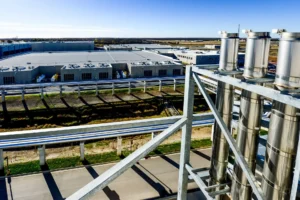Have Electrons, Will Compute
 Credit: Google
Credit: Google
Google is starting to develop data centers based on energy resource availability, develop renewables and storage projects co-sited with data centers, and then bring their fiber networks to that location to, rather than the other way around (siting a data center based on the fiber network).
I had seen some Inflation Reduction Act analysis that posited heavy manufacturing could set up shop in the upper plains to take advantage of plentiful constrained renewable power. This is not exactly the same thing, but it’s pretty close – a large demander of energy moving their operations to a not particularly convenient location to take advantage of the clean energy.
And the company isn’t the only one trying to respond to the drammatic surge in data center power demand with unique approasches – Exxon announced it was going to start building natural gas plants with carbon capture to be built adjacent to data centers – an interesting choice because although Exxon is a large oil and gas company, building power plants isn’t really its business specialty.
Meanwhile, Google also announced a large carbon dioxide removal purchase – 200,000 tons of enhanced rock weathering from Terradot – one of the largest purchases to date. A main value proposition of mineralization approaches such as this one is that the carbon removal is both extremely durable (since it is turning into a rock) and also straightforward to measure.
Permitting Delay
Unfortunately, permitting reform talks fell apart. There’s still a chance of some manner of permitting reform in this new congress (and plenty of appetite); however, currently Republican leadership is pushing to do permitting reform via reconciliation (which I am skeptical ofm, although people who are smarter than I am on this subject are less skeptical of). Given the narrow margins in the House and the actual bipartisan interest in permitting reform, it seems like there’s a clearer pathway for this as traditional legislation to me, but my predictive track record on federal affairs is pretty weak.
Alcohol in Illinois
Avina Clean Hydrogen recently announced plans to build a sustainable aviation fuel facility in southern Illinois, with the help of a $40M state subsidy. Beyond a project in my backyard, this one stuck out to me because it is an alcohol-to-jet pathway for aviation fuel (ie using ethanol). In addition to being a more scalable approach than the HEFA pathway (ie used cooking oil), the biggest player in the US in the alcohol-to-jet pathway is Chicago area LanzaJet. Illinois also sits at the convenient intersection of ethanol production on the one hand, and robust energy and transportation infrastructure on the other. Perhaps the beginnings of an industy cluster?
Not Cruising Anymore
GM pulled the plug on its Cruise robotaxi service and will shift strategy to self-driving features for personal vehicles. This is as Google’s Waymo is successfully ramping up its operations and grabbing ride haliing market share from Uber and Lyft.
It’s Getting Hot in Here
Record setting temperatures are surprising researchers, and creating concern that the earth may be warming even faster than it has been projected to (although more research is needed).
Electric Vehicle Quick Hits:
- Surprisingly, new research using real world conditions suggests electric vehicle batteries may last significantly longer than originally projected
- The US battery recycling ecosystem is starting to grow, with Redwood Materials on track to hit $200 million in revenue in 2024
- China has 76% market share of electric vehicles globally
Small SUVs are now the cleanest category of new vehicles, because although SUVs are less fuel efficient than cars overall, a larger percentage of those sold in the US are electric.